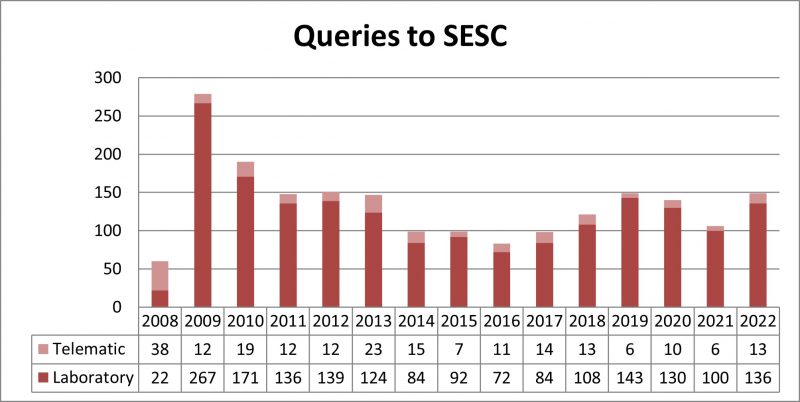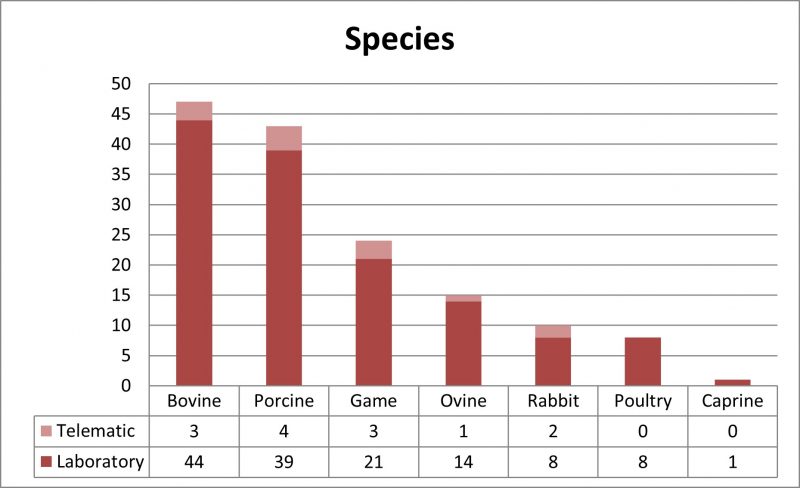Annual summary 2022
During 2022, SESC has managed a total of 148 inquiries. Of these, 13 were online inquiries and the remaining 135 corresponded to requests for laboratory analysis of samples.
Below we present a summary of this year's data. We take the opportunity, once again, to thank the collaboration and effort of the pathologists and experts in animal health from both the IRTA-CReSA, the SDPV and the Faculty of Veterinary Medicine of the UAB as well as the staff of the Public Health Agency of Catalunya (ASPCAT), especially to the official meat inspectors who, with their contributions, make the success of this page and this service possible.

Evolution of the number of inquiries submitted to SESC.

Distribution by species of inquiries submitted to SESC. The cattle sector, once again, is the one that provides the most samples, especially for the confirmation of diagnosis of zoonoses such as tuberculosis and bovine cysticercosis. Compared to previous years, poultry and rabbit inquiries have increased, and the absence of horse inquiries stands out.
After a year of operation of the new website we evaluate its implementation positively and so have the users themselves: despite a low participation in the response to the survey sent (only 10 out of 140 respondents have responded) the overall average rating has been 8.9/10, that of the the blog 9.4/10, of the Atlas 9.1/10 and of the online forms 9/10.
Regarding the remission of granulomas, as every year we have fallen short of the target of 100 granulomas in the bovine species since only 22 have been sent (of which 6 have been confirmed as Tuberculosis). The drop in the percentage of confirmation (which is usually around 50%) is due to the fact that we are at a time of very low prevalence of bovine TB in the country, in fact, Catalonia has been classified as an officially bovine tuberculosis-free area this year. The role of the SESC and the official veterinary inspectors in the achievement of this milestone must be emphasized and, above all, it must be emphasized that passive surveillance at the slaughterhouse level takes on more importance than ever, especially if the intensity of the active surveillance were to be reduced. It is also important to point out that tuberculosis has not been eradicated from Catalonia and we have other domestic and wild reservoirs: for example in wild boar through the SESC we have confirmed 8 cases of TB among the 11 suspicions referred during 2022. As a counterpoint, also it should be noted that there is a low number of sheep and goat granulomatous lesions reported (only 4 ovine granulomas submitted during 2022).
We are still under the threat of PPA in the European Union and it is necessary to highlight the good level of alertness of the inspectors who, during 2022, sent samples from 15 animals with erythematous lesions that could have been compatible with this disease.
Finally, we should highlight the detection of an outbreak of sheep pox through a consultation sent to the SESC, it is a disease that had been eradicated from our country for more than 5 decades. This detection highlights the role of the SESC and veterinary inspectors in the monitoring of diseases relevant to animal health. (EV)
Table 1: Summary of suspected notifiable diseases and zoonoses of the veterinarians submitting the samples and other processes that have been diagnosed.
| SUSPICIONS AND DIAGNOSES |
| SUSPICION |
Nº of inquiries |
% Confirmation of suspicion |
DIAGNOSTICS |
| Lesions compatible with Tuberculosis* |
50 |
26% (13/50) |
| Tuberculosis |
13** |
| Bacterial pyogranulomatous lymphadenitis |
7 |
| Corynebacterium pseudotuberculosis |
5 |
| No lesions |
3 |
| Linfadenitis piogranulomatosa (R. equii) |
2 |
| Verminous pneumonia |
2 |
| Pyogranulomatous lymphadenitis (Staphylococcus coag+) |
1 |
| Bacterial purulent lymphadenitis (Trueperella pyogenes) |
1 |
| Bacterial purulent lymphadenitis (P.multocida + Moraxella spp.) |
1 |
| Chronic bacterial granulomatous-necrotizing lymphadenitis (E. coli) |
1 |
| Granulomatous and necrotizing lymphadenitis (undetermined etiology) |
1 |
| Lymphadenitis + Granulomatous pneumonia (etiology not determined) |
1 |
| Mesothelioma |
1 |
| Fungal pyogranulomatous lymphadenitis |
1 |
| Multiple abscesses |
1 |
| Chronic multifocal necrotizing bronchopneumonia |
1 |
| Mycoplasma bovis, M.haemolytica, P.multocida and T.pyogenes |
1 |
| Pasteurella multocida |
1 |
| Pleuopneumonia abscessing (T. pyogenes) |
1 |
| Pneumonia + bacterial hepatitis. |
1 |
| Chronic bacterial pneumonia. |
1 |
| Grangrenous pneumonia |
1 |
| Granulomatous pneumonia and lymphadenitis. |
1 |
|
|
| Lesions compatible with Cysticercosis |
9 |
11.11% (1/9) |
| Cysticercosis |
1 |
| Pyogranulomatous plant foreign body glossitis |
1 |
| Eosinophilic myositis |
1 |
| Fibrous lesion on the tongue. |
1 |
| Fibrosis + masseter bone metaplasia |
1 |
| Cartilaginous metaplasia |
1 |
| Endomyocarditis and eosinophilic epicarditis. |
1 |
| Peripheral nerve sheath tumor |
1 |
| Heart neoplasm |
1 |
|
| Lesiones compatible with CSF/ASF*** |
15 |
0% (0/15) |
| Nonspecific hemorrhagic diathesis. |
6 |
| Porcine dermatitis and nephropathy syndrome (PDNS) |
5 |
| Erysipelas |
1 |
| Stress and Transportation Fights-Related lesions |
1 |
| Necrosis punta de les orejas |
1 |
| Probable hipertermia |
1 |
|
*This classification includes samples received in which, although the inspector did not suspect TB, the lesion was macroscopically compatible.
**TB diagnoses correspond to cattle 5 TB (4 confirmed MTBC by PCR/culture, one PCR-culture pending) and wild boar 8 TB (confirmed MTBC by PCR/culture).
In all cases, infection was ruled out by molecular diagnosis (PCR) and histopathological study.
Table 2: Summary of inquiries and diagnoses
| Category |
N |
DIAGNOSES |
| Infectious |
58 |
| TBC (13) |
| Bacterial pyogranulomatous lymphadenitis (7) |
| Corynebacterium pseudotuberculosis (5) |
| Pyogranulomatous lymphadenitis (R. equii) (2) |
| Marek's disease(2) |
| Pasteurella multocida (2) |
| Sheep pox (2) |
| Erysipelas (2) |
| Orf (1) |
| Encefalitozoonosis + Staphylococcus (1) |
| Encephalitozoonosis (1) |
| Lymphadenitis + granulomatous pneumonia (compatible with TB not confirmed) (1) |
| Bacterial necrotizing dermatitis (Staphylococcus coag+, E. coli) (1) |
| Chronic bacterial granulomatous-necrotizing lymphadenitis (E. coli) (1) |
| Bacterial pyogranulomatous lymphadenitis (Staphylococcus coag+) (1) |
| Bacterial suppurative lymphadenitis (Pasteurella multocida + Moraxella spp.) (1) |
| Bacterial suppurative lymphadenitis (Trueperella pyogenes) (1) |
| Abscesses due to Staphylococcus coag+ (Enf. Morel) + Maedi visna (1) |
| Anaplasma ovis (1) |
| Multiple abscesses (1) |
| Morel's disease (1) |
| Mycoplasma bovis (1) |
| Mycoplasma bovis, M.haemolytica, P.multocida i T.pyogenes (1) |
| Absedifying pleuopneumonia (T. pyogenes) (1) |
| Fibirnopurulent pleuopneumonia (T.pyogenes + P.multocida) (1) |
| Chronic bacterial pneumonia. (1) |
| Gangrenous pneumonia (1) |
| PRRS (1) |
| Regressive atrophic rhinitis (P. multocida negative to dermonecrotoxin) (1) |
| Synovitis and osteomyelitis due to Mycoplasma synoviae (1) |
| Avian smallpox (1) |
|
| Fungal |
1 |
Fungal pyogranulomatous lymphadenitis (1) |
| Neoplasia |
9 |
| Mesothelioma (1) |
| Uterine leiomyoma + Ascaridia galli (1) |
| Heart neoplasm (2) |
| Muscle lymphosarcoma (1) |
| Peripheral nerve sheath tumor (1) |
| Papilloma (1) |
| Nephroblastoma (1) |
| Lymphoma (1) |
|
| Parasites |
8 |
| Uterine leiomyoma + Ascaridia galli (1) |
| Parasitic hepatitis (Cysticercus pisiformis) (1) |
| Cysticercus pisiformis (+ degenerative hepatopathy + lymphoplasmacytic cholangiohepatitis) (1) |
| Bovine cysticercosis (1) |
| Besnoitia (1) |
| Verminous pneumonia(1) |
| Trichinella is ruled out (compatible with Toxócara or pulmonary nematodes) (1) |
|
| Inflammatory |
26 |
| PDNS (5) |
| Septicemia + Avian infectious bronchitis (1) |
| Granulomatous pneumonia and lymphadenitis (1) |
| Pneumonia + bacterial hepatitis. (1) |
| Pyogranulomatous vegetable foreign body glossitis (1) |
| Eosinophilic myositis (1) |
| Chronic proliferative peritonitis (1) |
| Endomyocarditis and eosinophilic epicarditis (1) |
| Regressive atrophic rhinitis (1) |
| Eosinophilic lymphadenitis (1) |
| Necrotizing hepatitis (undetermined etiology) (1) |
| Chronic necrotizing lymphoplasmocytotic panniculo-myositis (vaccine reaction ?) (1)
Chronic interstitial nephritis(1) |
| Hypersensitivity (subcutaneous tissue)) (1) |
| Muscle abscesses and nephritis (1) |
| Necrotizing granulomatous fasciitis and panniculitis (1) |
| Chronic multifocal necrotizing bronchopneumonia (1) |
| Granulomatous and necrotizing lymphadenitis (1) |
| Fat necrosis (1) |
| Myositis and cellulitis (Clostridial?) (1) |
| Infectious cellulitis of the chin (compatible with avian cholera, Pasteurella) (1) |
| Embolic nephritis (1) |
|
| Others |
46 |
| Jaundice in pig carcasses (11) |
| Hemorrhagic diathesis (no specific diagnosis) (6) |
| No lesions (5) |
| Jaundice vs Carotenes (3) |
| Hepatic cyst (3) |
| Probable torsion/splenic infarction (2) |
| Urinary stones (urates) (1) |
| Melanosis (1) |
| Injuries associated with stress and fights in transport (1) |
| Consultation on seizure of pig lungs (1) |
| Degenerative liver disease (toxic or metabolic)) (1) |
| Fibrous lesion in the tongue (1) |
| Fibrosis + masseter bone metaplasia (1) |
| Muscle lipomatosis (1) |
| Phosphate urinary stones (1) |
| Hydronephrosis (1) |
| Cartilaginous metaplasia (1) |
| Congenital polycystic kidney (1) |
| Porcine intestinal emphysema (1) |
| Necrosis of the tip of the ears (1) |
| Probable hyperthermia (1) |
| Aujeszky suspicion ruled out (1) |
|
|




1 comment(s)
Molt bona feina! Exemple clar de feina col.laborativa que dóna resultats compartits amb tothom, la qual cosa sempre suposa aprenentatge. Gràcies!